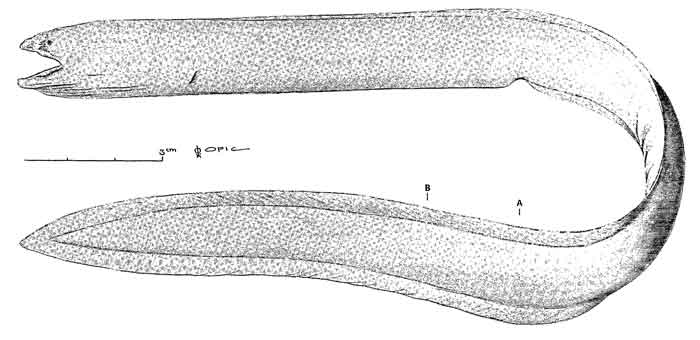Superregnum: Eukaryota
Cladus: Unikonta
Cladus: Opisthokonta
Cladus: Holozoa
Regnum: Animalia
Subregnum: Eumetazoa
Cladus: Bilateria
Cladus: Nephrozoa
Superphylum: Deuterostomia
Phylum: Chordata
Subphylum: Vertebrata
Infraphylum: Gnathostomata
Megaclassis: Osteichthyes
Superclassis/Classis: Actinopterygii
Classis/Subclassis: Actinopteri
Subclassis/Infraclassis: Neopterygii
Infraclassis: Teleostei
Megacohors: Elopocephalai
Supercohors: Elopocephala
Cohors/Superordo: Elopomorpha
Ordo: Anguilliformes
Subordo: Anguilloidei
Familia: Heterenchelyidae
Genus: Pythonichthys
Species: P. asodes – P. macrurus – P. microphthalmus – †P. pirabasensis – P. sanguineus
Name
Pythonichthys Poey, 1868
Type species: Pythonichthys sanguineus Poey, 1868
References
Poey, F. 1867–1868. Monografia de las Morenas cubanas. Repertorio Fisico-Natural de la Isla de Cuba 2: 245–268, 2 pls. BHL Reference page.
Links
Pythonichthys and its species (including synonyms) in Catalog of Fishes, Eschmeyer, W.N., Fricke, R. & van der Laan, R. (eds.) 2024. Catalog of Fishes electronic version.
Pythonichthys species list in FishBase,
Froese, R. & Pauly, D. (eds.) 2024. FishBase. World Wide Web electronic publication, www.fishbase.org, version 02/2024.

Pythonichthys microphthalmus
Pythonichthys is a genus of eels of the family Heterenchelyidae that occur in tropical waters of the eastern Pacific Ocean off of Panama and in the Atlantic Ocean near the Caribbean Sea and the west coast of Africa. It contains the following described species:[2]
Pythonichthys asodes Rosenblatt & Rubinoff, 1972 (Pacific mud eel)
Pythonichthys macrurus (Regan, 1912) (Long-tailed short-faced eel)
Pythonichthys microphthalmus (Regan, 1912) (Short-tailed short-faced eel)
Pythonichthys sanguineus Poey, 1868 (no common name)
In addition, the fossil species Pythonichthys arkansasensis Schwarzhans & Stringer, 2020 is known by otoliths from the Late Cretaceous (Maastrichtian) and Early Paleocene of Texas and Arkansas, USA. Its fossils are very common in formations shortly after the Cretaceous-Paleogene extinction event, suggesting that it was a disaster taxon that thrived in the wake of the extinction.[3][4]
References
Eschmeyer, William N.; Fricke, Ron & van der Laan, Richard (eds.). "Genera in the family Heterenchelyidae". Catalog of Fishes. California Academy of Sciences. Retrieved 10 November 2024.
"WoRMS - World Register of Marine Species - Pythonichthys Poey, 1868". www.marinespecies.org. Retrieved 2024-02-18.
Schwarzhans, Werner; Stringer, Gary L. (2020-05-06). "Fish Otoliths from the Late Maastrichtian Kemp Clay (Texas, Usa) and the Early Danian Clayton Formation (Arkansas, Usa) and an Assessment of Extinction and Survival of Teleost Lineages Across the K-Pg Boundary Based on Otoliths". Rivista Italiana di Paleontologia e Stratigrafia. 126 (2). doi:10.13130/2039-4942/13425. ISSN 2039-4942.
Schwarzhans, Werner W.; Jagt, John W. M. (2021-11-01). "Silicified otoliths from the Maastrichtian type area (Netherlands, Belgium) document early gadiform and perciform fishes during the Late Cretaceous, prior to the K/Pg boundary extinction event". Cretaceous Research. 127: 104921. Bibcode:2021CrRes.12704921S. doi:10.1016/j.cretres.2021.104921. ISSN 0195-6671.
Froese, Rainer; Pauly, Daniel (eds.). "Species in genus Pythonichthys". FishBase. June 2011 version.
Retrieved from "http://en.wikipedia.org/"
All text is available under the terms of the GNU Free Documentation License

